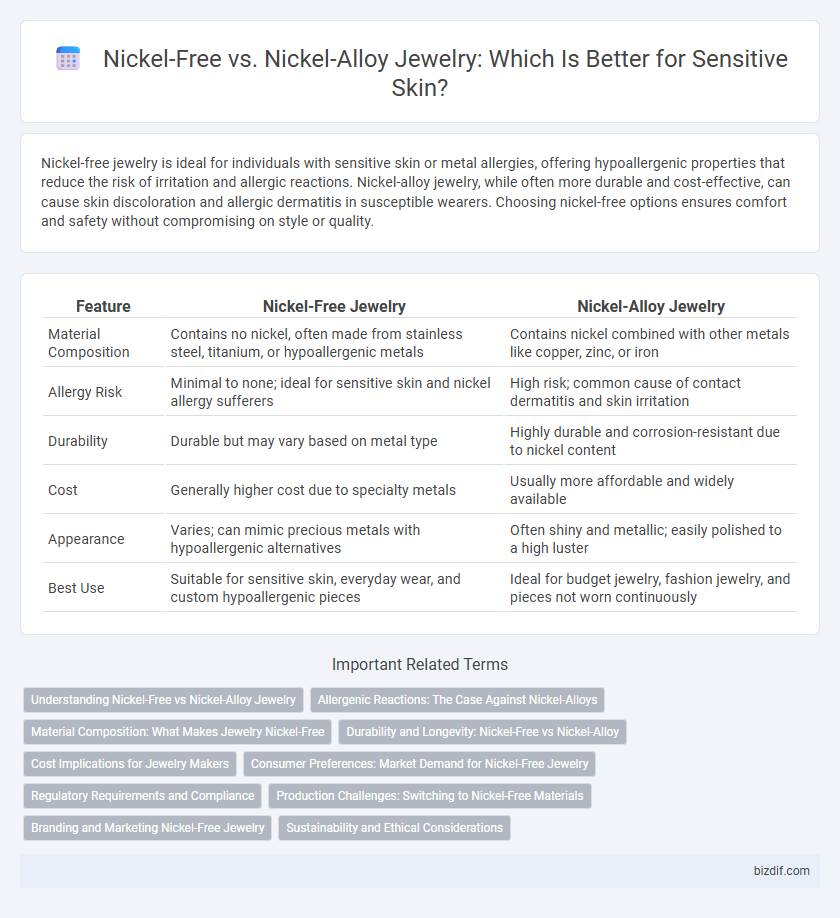Nickel-free jewelry is ideal for individuals with sensitive skin or metal allergies, offering hypoallergenic properties that reduce the risk of irritation and allergic reactions. Nickel-alloy jewelry, while often more durable and cost-effective, can cause skin discoloration and allergic dermatitis in susceptible wearers. Choosing nickel-free options ensures comfort and safety without compromising on style or quality.
Table of Comparison
| Feature | Nickel-Free Jewelry | Nickel-Alloy Jewelry |
|---|---|---|
| Material Composition | Contains no nickel, often made from stainless steel, titanium, or hypoallergenic metals | Contains nickel combined with other metals like copper, zinc, or iron |
| Allergy Risk | Minimal to none; ideal for sensitive skin and nickel allergy sufferers | High risk; common cause of contact dermatitis and skin irritation |
| Durability | Durable but may vary based on metal type | Highly durable and corrosion-resistant due to nickel content |
| Cost | Generally higher cost due to specialty metals | Usually more affordable and widely available |
| Appearance | Varies; can mimic precious metals with hypoallergenic alternatives | Often shiny and metallic; easily polished to a high luster |
| Best Use | Suitable for sensitive skin, everyday wear, and custom hypoallergenic pieces | Ideal for budget jewelry, fashion jewelry, and pieces not worn continuously |
Understanding Nickel-Free vs Nickel-Alloy Jewelry
Nickel-free jewelry is crafted without nickel to prevent allergic reactions commonly triggered by nickel exposure, making it ideal for sensitive skin. Nickel-alloy jewelry contains nickel combined with other metals, providing enhanced durability and affordability but potentially causing irritation for individuals with nickel allergies. Selecting jewelry based on nickel content is crucial for both comfort and long-term wearability.
Allergenic Reactions: The Case Against Nickel-Alloys
Nickel-alloy jewelry often triggers allergenic reactions, as nickel is one of the most common metal allergens causing contact dermatitis and skin irritation. Nickel-free jewelry is specifically designed to eliminate these risks, making it ideal for individuals with sensitive skin or nickel allergies. Choosing nickel-free metals in jewelry making reduces the incidence of allergic responses significantly, ensuring safer wear and increased comfort.
Material Composition: What Makes Jewelry Nickel-Free
Nickel-free jewelry is crafted using alternative materials such as surgical-grade stainless steel, titanium, or high-purity gold and silver alloys that exclude nickel to prevent allergic reactions. Unlike nickel-alloy jewelry, which contains varying percentages of nickel to enhance durability and shine, nickel-free pieces rely on hypoallergenic metals or coatings to ensure skin safety. The primary difference in material composition lies in the absence of nickel ions, making nickel-free jewelry ideal for individuals with nickel sensitivities.
Durability and Longevity: Nickel-Free vs Nickel-Alloy
Nickel-alloy jewelry offers superior durability and resistance to tarnish, making it a popular choice for pieces intended to last through daily wear and exposure to elements. Nickel-free jewelry, while less durable, reduces the risk of allergic reactions, making it ideal for sensitive skin but often requiring more careful handling to maintain its appearance. Choosing between nickel-free and nickel-alloy ultimately depends on balancing the need for longevity with skin sensitivity and maintenance preferences.
Cost Implications for Jewelry Makers
Nickel-free materials typically incur higher costs for jewelry makers due to the need for alternative hypoallergenic metals, which can be more expensive and less readily available than nickel-alloys. Nickel-alloys offer a cost-effective option by combining durability and affordability, but they may require additional treatments to prevent skin irritation and allergic reactions. The choice between nickel-free and nickel-alloy impacts production expenses, pricing strategies, and target market segments focused on health-conscious consumers.
Consumer Preferences: Market Demand for Nickel-Free Jewelry
Consumer preferences increasingly favor nickel-free jewelry due to rising awareness of nickel allergies, which affect up to 17% of the population. Market demand for hypoallergenic nickel-free pieces drives manufacturers to use alternative metals like titanium, stainless steel, and sterling silver. Nickel-alloy jewelry remains popular for its affordability and durability but faces declining demand in regions with strict allergen regulations.
Regulatory Requirements and Compliance
Nickel-free jewelry complies with stringent regulatory standards such as the EU Nickel Directive, limiting nickel release to prevent allergic reactions. Nickel-alloy pieces must meet specific thresholds outlined by the REACH regulation to avoid skin sensitization risks. Ensuring compliance involves rigorous testing for nickel migration and certification to maintain safety and market access globally.
Production Challenges: Switching to Nickel-Free Materials
Switching to nickel-free materials in jewelry production poses challenges such as sourcing durable alternatives that maintain aesthetic appeal and meet hypoallergenic standards. Manufacturers must invest in reformulating alloys like titanium or stainless steel to replicate nickel's strength and malleability while avoiding allergic reactions. These adjustments increase production costs and require modified melting temperatures and casting techniques to ensure product quality and longevity.
Branding and Marketing Nickel-Free Jewelry
Nickel-free jewelry is increasingly favored in branding and marketing due to its hypoallergenic properties, appealing to sensitive skin consumers and health-conscious buyers. Emphasizing "nickel-free" highlights safety, quality, and comfort, differentiating products from nickel-alloy counterparts that may cause allergic reactions. Brands leverage this feature to build trust, promote inclusivity, and align with ethical and environmentally friendly values, boosting customer loyalty and expanding market reach.
Sustainability and Ethical Considerations
Nickel-free jewelry reduces allergic reactions and supports ethical labor practices by avoiding toxic nickel mining processes linked to environmental degradation. Nickel-alloy components, while durable and cost-effective, often involve unsustainable extraction methods and pose health risks to sensitive individuals. Choosing nickel-free materials aligns with sustainable sourcing and prioritizes consumer safety in ethical jewelry production.
Nickel-free vs Nickel-alloy Infographic

 bizdif.com
bizdif.com